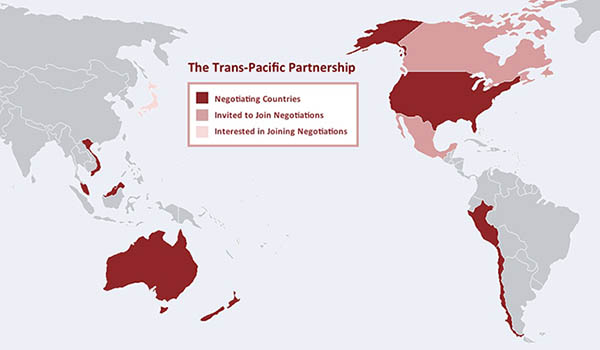Trade ministers from 12 countries—including the US and Canada—failed to come to agreement at their final meeting in Singapore late last year on the Trans-Pacific Partnership (TPP). However, the world’s largest economic treaty in history is hardly dead in the water. While many of the proposed terms of the TPP are still shrouded in mystery, there is widespread agreement that the deal has reached a “tipping point” for North American supply chain managers.
Indeed, Canadian and American stakeholders are being urged by trade lobbyists to call on their governments to ensure the agreement includes long-term measures to deal with chokepoints in trade and the supply chain, The most urgent of these is the post-9/11 security measures between the US and Canada border that are impeding the facilitation of goods and services and risking economic security. Other pressing issues include inadequate infrastructure and redundant regulations that have plagued logistics managers for decades.
James D. Philips, President & CEO, Canadian-American Border Trade Alliance, calls the pending deal “NAFTA 2.0” for the fast-growing Asia Pacific Region. As the world’s largest free trade zone, the TPP would give Canada preferential trade and investment access to dynamic new markets. This represents a coveted door of opportunity that may accelerate our hemisphere’s economic recovery.
Philips will be among the speakers sharing market intelligence at the inaugural Cargo Logistics Canada (CLC) Expo in Vancouver on January 29-30, 2014. In an interview with Supply Chain Management Review, he notes that past trade agreements used to deal mostly just with goods, while today’s iteration encompass a broad range of regulatory and legal issues, making them a much more central part of foreign policy and domestic lawmaking.
“Last year, for example, we saw the first-ever joint U.S.-Canada Border Infrastructure Investment Plan (BIIP),” says Phillips. “The development and release of this initiative fulfills a commitment made under the ‘2011 United States-Canada Beyond the Border Action Plan.’”

The BIIP is an interagency and bi-national planning mechanism developed to establish a mutual understanding of recent, ongoing, and potential border infrastructure investments. It outlines the approach that the US and Canada will take to coordinate plans for physical infrastructure upgrades at small and remote ports of entry. This initiative will be updated and disseminated annually, and follows recent announcements by Canada of significant investments at inland cargo gateways like North Portal, Saskatchewan, which serves Pacific Rim trade.
At the same time, the US and Canada announced a pilot project at the Port of Prince Rupert to eliminate duplicate security checks of marine cargo that enters Canada but is destined for the United States by rail. Under the new approach, cargo is screened only once, at its initial port of arrival, after which it is free to move across the U.S.-Canada border without the need for further inspections – embracing the principle of “screened once, accepted twice.”
As we await the eventual passage of TPP, trade experts maintain that modernization of major West Coast border crossings will reduce wait times, increase reliability of just-in-time shipments, and decrease fuel consumption and greenhouse gas emissions.
Meanwhile, President Barack Obama and Canadian Prime Minister Stephen Harper appear to be on the same page when it comes to “version two” of NAFTA – and that can only mean good things for Pacific Rim shippers.
Related Content on Supply Chain 24/7: NAFTA 20 years later
SC
MR

Latest Supply Chain News
- Survey reveals strategies for addressing supply chain, logistics labor shortages
- Israel, Ukraine aid package to increase pressure on aerospace and defense supply chains
- How CPG brands can deliver on supplier diversity promises
- How S&OP provides the answer to in-demand products
- AI, virtual reality is bringing experiential learning into the modern age
- More News
Latest Podcast

 Explore
Explore
Topics
Latest Supply Chain News
- Survey reveals strategies for addressing supply chain, logistics labor shortages
- Israel, Ukraine aid package to increase pressure on aerospace and defense supply chains
- How CPG brands can deliver on supplier diversity promises
- How S&OP provides the answer to in-demand products
- AI, virtual reality is bringing experiential learning into the modern age
- Humanoid robots’ place in an intralogistics smart robot strategy
- More latest news
Latest Resources

Subscribe

Supply Chain Management Review delivers the best industry content.

Editors’ Picks





